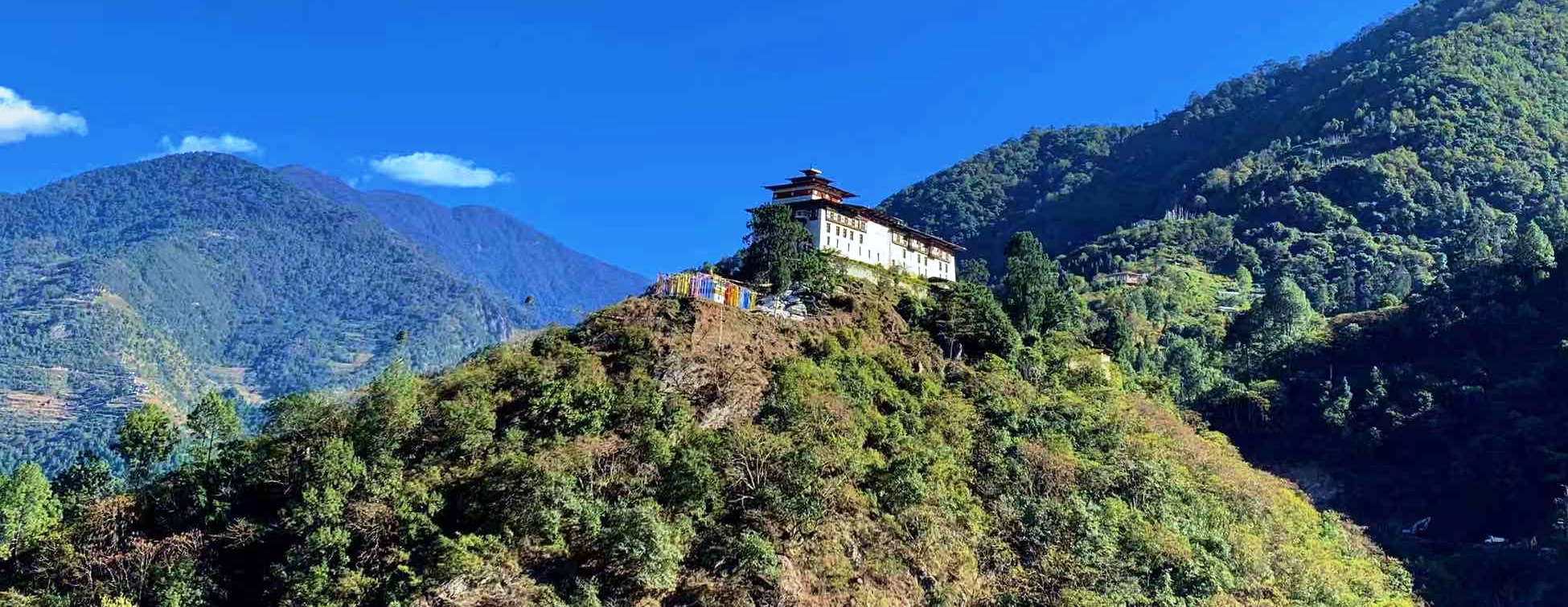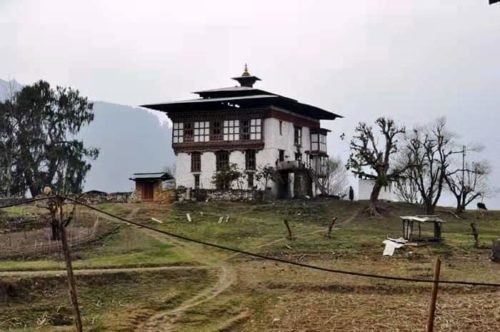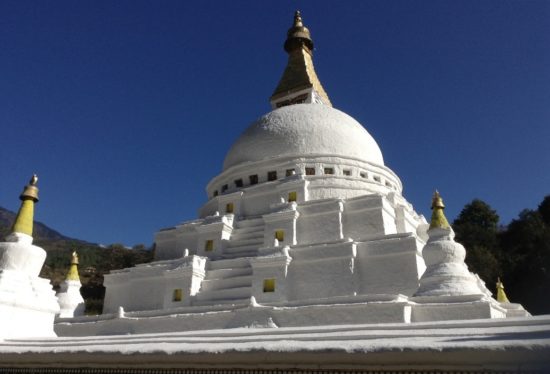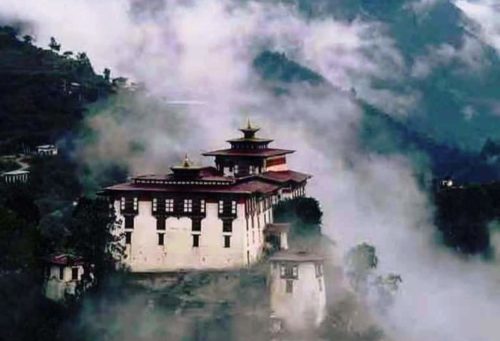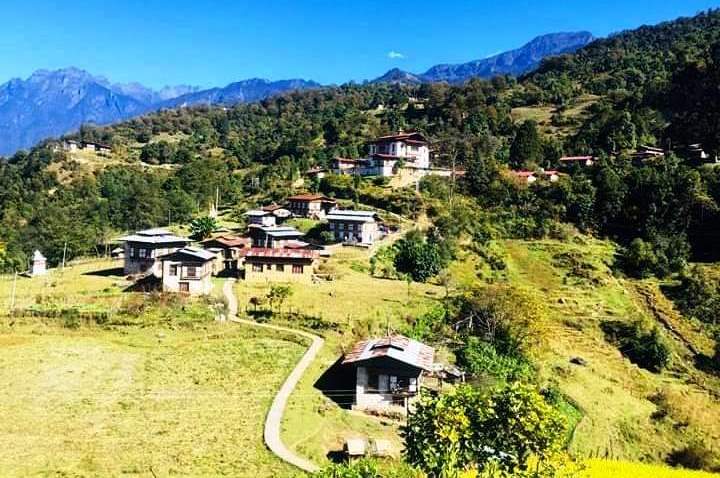A Eastern Bhutan trip is more mesmerizing as the tour covers all natural beauty of the country and amazing cultural sites with rich history starting from west to central part and finally to the remote eastern Bhutan. A two weeks tour will give you insight into rural culture and history of different regions that have their own charm and uniqueness.
The drive to the east is a most fascinating journey as it passes through most scenic roads in Bhutan with sheer-drop cliffs, gorgeous waterfalls and a few deep river valleys. You will also come across many bird species as you drive through dense forests consisting of rich flora and fauna, and the settlements mostly perched on the hilltops with dry lands farming.
You could start this trip from the Paro airport (west) and end from far Eastern Bhutan and finally exit or fly via Guwahati Airport in India, or vice-versa as well. So you could see pretty enough of what you need to see and learn about this tiny kingdom if you embark on this cultural tour.
Trip Highlights
- Sightseeing in Thimphu
- Trashichho dzong
- Taktsang Monastery (The Tiger’s Nest)
- Handicrafts emporium
- Punakha Dzong
- Drugyel Dzong victory fortress
SHORT ITINERARY
Day 01 :
Bangkok – Paro then transfer to Thimphu. Overnight at a hotel.
Day 02 :
ParoTaktsang (Tiger’s Nest) hike – Thimphu. Overnight at a hotel.
Day 03 :
Thimphu sightseeing. Overnight at a hotel.
Day 04 :
Thimphu – Punakha. Overnight at a hotel.
Day 05 :
Punakha – Trongsa via Gangtey valley. Overnight at a hotel.
Day 06 :
Trongsa sightseeing – Bumthang. Overnight at a hotel.
Day 07 :
Bumthang Valley sightseeing. Overnight at a hotel.
Day 08 :
Bumthang – Mongar. Overnight at a hotel.
Day 09 :
Mongar – Lhuntshe excursion. Overnight at a hotel.
Day 10 :
Mongar – Trashigang. Overnight at a hotel.
Day 11 :
Trashigang – Trashiyangtse excursion. Overnight at a hotel.
Day 12 :
Trashigang – Samdrup Jongkhar. Overnight at a hotel.
Day 13 :
Paro departure. Transfer to the international airport for your final departure.
Day 01: Arrive Paro (By Druk Air)
The flight into Paro on our national carrier, Druk Air, is a befitting introduction to the spectacular beauty of our country. In clear weather, magnificent views of the world’s highest peaks, give way to the lush green Paro valley as you land. On arrival at Paro international airport, you will be received by our representative and will escort you to hotel. In the afternoon visit is Ta Dzong, an ancient watchtower, which now houses the National Museum. Below the museum is the Paro Rimpung Dzong, the centre of civil and religious authority in this valley. A short walk takes you to the base of the dzong and across a traditional cantilevered, covered bridge. A short distance further is one of the innumerable archery grounds. (Archery is the national sport of Bhutan). If we are lucky, we may catch a match in action. Overnight stay in Paro.
Day 02: ParoTaktsang (Tiger’s Nest) hike – Thimphu (55 km)
Right after the breakfast drive towards the road point to Taktshang. Taktshang Monastery, the most famous of Bhutan’s monasteries. Taktshang means “Tiger’s Nest,” so named because Guru Rimpoche reportedly flew to the site of the monastery on the back of a flying tiger in the late centuries of the first millennium. The monastery is perched on a cliff nearly 3,000 ft above the Paro valley floor. This day hike is not only historically and culturally interesting, but also incredibly scenic! It takes about hour and half to reach the cafeteria, which gives a breathtaking view of the Tiger’s Nest. If you still feel like hiking then you can take another hour to reach the temple. Then return back hiking all downhill to your car, and then evening drive to Thimphu takes little over one hour. In the evening you can explore Thimphu, the capital of Bhutan, and absorb the lifestyle of the people. Overnight in Thimphu.
Day 03:Thimphu sightseeing
In the morning drive to Buddha Point to see the largest statue of Buddha Sykhamuni in the world from where you could also view the entire capital city of Bhutan. Visit the school of Arts and Crafts which was established to preserve and promote our age old arts and crafts. The students here are taught 13 different traditional arts. Visit the folk Heritage museum, to see the house of living traditions in some of the rural areas or the replica of living house in olden days. Visit the Memorial stupa which was built in the memory of our beloved 3rd King in1974. You can also visit some interesting handicraft shops. Overnight stay in Thimphu.
Day 04: Thimphu – Punakha (70 km)
After breakfast, go to Bhutan National Bank for currency exchange and then you can get an opportunity to visit the Bhutan Post to purchase exquisite collector Bhutanese stamps. Then drive to Punakha. (The ancient capital of Bhutan) is 2 hours drive from Thimphu across Dochu-La Pass. (Alt. 11,400 ft) snow-capped eastern Himalayan ranges can be seen on a clear day. Prayer flags will flutter you over the pass deeper into the essence of Bhutan. Once you cross the pass, you wind down into a warm fertile valley and meander along a gently flowing aquamarine river that leads you to the Punakha valley. After lunch visit the Punakha dzong, the winter residence of the Je khempo (chief abbot). Punakha dzong is the second dzong system built in Bhutan by Shabdrung Nawang Namgyel in the year 1637. The Dzong is said to be the most beautiful of dzong in Bhutan; it is an outstanding structure with intense artwork. Over night at the hotel in Punakha.
Day 05: Punakha – Trongsa via Gangtey valley (157 km)
Today drive early to Phobjikha valley, A broad glacial valley (10’000 ft) on the flanks of the Black Mountains, Phobjikha with its gently slop is a place of astonishing beauty described as” the most beautiful valley in the most beautiful country of Himalayas”. Every winter, the rare and beautiful black-necked cranes return from Tibet to the Gangtey valley where they are protected. Gangtey also has a very interesting Nyingmapa monastery, the only one of the only one of its kind west of the Black Mountain range. The monastery is renovated by 9th Gangtey Tulku Rimpoche. After lunch Drive to Trongsa via Pelela Pass (3100 meters). On the stop Chendebji Chorten, designed after Katmandu’s Swayambhunath stupa, with eyes painted at the four cardinal points. It was built in the 18 century by Lama Shidha, to cover the remains of an evil spirit that was subdued at this spot. Night halt at the hotel in Trongsa.
Day 06: Trongsa sightseeing – Bumthang (67 km)
In the morning visit Trongsa Dzong, built in 1648; it was seat of power over central and eastern Bhutan. Both the first and second kings ruled the country from this ancient seat. All the five kings were invested as Trongsa Penlop(Governor) prior to ascending the throne. The fortress is presently the administrative seat of the district and the home of the monastic school. Built at split-levels on a narrow spur, the dzong offers magical wonder. The watchtower, located directly above the dzong, before used to have many interesting armors and other weapons of war used by ancient warriors which is converted into a museum just few years ago also. And it’s interesting to see this museum, though it’s new. Continue onwards to Jakar and overnight at the hotel in Bumthang.
Day 07: Bumthang Valley sightseeing
The valley is one of the most beautiful valleys in the kingdom. It is also the religious heartland where many saints and masters meditated leaving their imprints as sacred places of worship and pilgrimage Tales of Pedmasambhava dominate these holy shrines. In the morning visit, Jampa Lhakhang which is built by Tibetain King Songtshen Gompa in 7th century and then drive to Kurji Lhakhang were body imprints of Guru Rimpoche remains preserved upon a rock. Then short hike to Tamzhing Monastery. If the weather is clear, you will enjoy the view of green valley, dotted with hundreds tempals, thousand flags and beautiful chamkhar river flow through the valley. The valley is also called mini Switzerland of Bhutan.
Day 08: Bumthang – Mongar (190 km)
Drive towards Eastern Bhutan is spectacular with the views of mountains, hamlets, waterfalls and several birds en-route. On the way, you will pass through Ura valley which lies at an altitude of 10,000 feet. The differences between Eastern and Western Bhutan are far greater than the high pass that separates them. History has played a significant role with the kingdom only being unified with the east at the end of the last century and prior to that many wars separated each side. Thrumshing La pass and a seven-hour drive separate Ura from Mongar in the East.
The journey is one of the most beautiful in all the Himalayas. The descent from Thrumshing La to Lingmithang is astonishing for several reasons. The road drops from 3,800 meters to 650 meters in only a few hours passing from pine forest through semi-tropical forest to orange groves. Carved out of the side of the mountain, in parts the road’s edge borders a sheer cliff which drops thousands feet. Arriving at Mongar marks the beginning of your eastern Bhutan experience.
Eastern Bhutan is famous for its fine weaving. Weavers using backs trap looms produce cotton and silk cloth in incredible colors and patterns. Often natural colors are made from bark, leaves and flowers. The predominant ethnic group in Eastern Bhutan is Sharchops, who are generally followers of the Nyingma tradition of Buddhism and tend to be shorter and stockier than people in other parts of the country. Another characteristic of Eastern Bhutan is that the cities and towns are generally built on mountain slopes, a notable exception being Samdrup Jongkhar which is located in a valley on the Indian border. Sharchopkha is the predominant language of the region, though there are local variations. Some of the finest weaving villages in Bhutan are found in the Mongar area. Overnight halt stay at the hotel in Mongar.
Day 09: Mongar – Lhuntshe excrusion (74 km, one way)
Lhuentse is one of Bhutan’s remotest and least developed districts, and the landscape in the north is dominated by the Himalayas. The district is famous for its beautiful and intricate woven cloth. Lhuntshe is famous for its fine weaving. Weavers using blackstrap looms produce cotton and silk cloth in incredible colors and patterns. Often natural colors are made from bark, leaves and flowers. There are no shops selling it, but no doubt pieces can be bought by visiting the houses of weavers – the village of Khoma is an especially good place to look. You could eat lunch in a restaurant or guest house on the main street – a very simple guest house/hotels offering very basic amenities. Khoma – an hour walk from the main road to Lhuentse Dzong – famous for its intricate woven cloth called Kishu Tharas. Then drive back to Mongar and overnight in the same hotel.
Day 10: Mongar – Trashigang (92 km)
After Breakfast drive to Trashigang, today the rides take us over Kori la pass 3000 meters. After the pass the road is very beautiful as it has lots of soft turns called Yadi loops through beautiful pine trees. The pretty, lively town of Trashigang is a good jumping-off point to visit the kingdom’s wild east. Few travellers make it here but, as long as you’re happy to leave behind the relative comforts of Thimphu and Paro, exploring this neck of the woods can have its rewards. This is the most densely populated part of Bhutan but also most definitely the hinterland. Locals are fond of a tipple, and bodies sleeping off their excesses at the side of the road aren’t an unusual sight. This is a good place to sample the local arra and soak up the atmosphere (in that order). Villagers come to town on holy days, which occur on the first, 10th and 15th of the Bhutanese month. After selling their produce they get stuck into the arra and paint the town an unforgettable Bhutanese shade of red. Trashigang Dzong sits on a jagged piece of land jutting out from the town and is the first landmark that can be seen from the road winding up to Trashigang. The Dzong was built in 1659 and commands a spectacular view over the valley for which it is the administrative center. The Dzong is significant for the fact that it only has one courtyard.
Day 11: Trashigang – Trashiyangtse excursion (60 km, one way)
Chorten Kora – an impressive stupa similar to the famous Boudhanath Stupa in Kathmandu. Handmade wooden bowls (dappa) are a wonderful and practical souvenir. The halves of the bowl fit tightly together, so they can be used to carry cooked food, which is their function in Bhutan. However, they also make excellent salad or cookie bowls. Dappa are a speciality of the Trashi Yagtse region, and it is possible to purchase them directly from the workshops of dappa makers. In the Afternoon we will drive to Bomdeling Wildlife Sanctuary, established in 1995 in order to protect large areas of virtually untouched Eastern Himalayan ecosystems ranging from warm broadleaved forest to alpine region. It partly overlaps with the earlier Kulong Chhu National Park which mainly covered alpine and subalpine habitats. Altitudes in the sanctuary range from 1500 m in the south to over 6400m in the north. The northern parts include glaciers, snow peaks slopes, alpine pastures and scrub and glacial lakes and valleys. The central parts include ridges and valleys covered in scrubland, conifer forest and broadleaved forest. The southern and lower part consist more ridges, valleys and river gorges. Most are covered in broadleaved forest. Flatter areas have often been cleared for agricultural land and villages. Covering much of Trashi Yangtse district, this 1,550 sq km reserve provides sanctuary to rare animals such as blue sheep, snow leopards, red panda, musk deer and Himalayan black bear. Drive back to Trashigang hotel for the overnight stay.
Day 12: Trashigang – Samdrup Jongkhar (180 Km)
Today we have to start very early; today we will pass through Sherabtse University in Bhutan. Then to Khaling weaving center then finally to Samdrup Jongkhar the exit/enter point of Bhutan. Samdrup Jongkhar is boarder town to Assam boarder. Check in the hotel. Time to explore the town which is the main border with India for the eastern Bhutan. And you will have fare well dinner before we depart tomorrow. Night halt stay at the hotel.
Day 13: Samdrup Jongkhar – Guwahati, India (110 Km) – flight depart
Today we will drive to Gawahati which is 110 Km from Bhutan Boarder may take around 3 hours. The entire drive is in the plains.And then fly to Bangkok via our Drukair from Guwahati airport.
Tashi Delek and have a pleasant flight!
Below are the Costs details:
- Peak Season Cost: March, April, May, September, October & November
Daily Cost: USD 255 per night per person. - Regular Season Cost: June, July, August, December, January & February
Daily Cost: USD 210 per night per person - Bhutan Visa Fee: USD 40 per person per entry only
Note: Single Room Supplement Cost is, USD 30 per night for 3 Star hotels, USD 65 per night for 4 Star Hotels and around USD 200 and above for the 5 Star Hotels.
1. What is the cost for the trip and what type of accommodation do you provide? And what does the cost includes?
Ans; The Daily Cost for 2 persons; Peak Season is USD 255 per person per night, and USD 210 per night per person for Regular Season. And then you will get S.D.F USD 65 per night off as you travel through the eastern region’s districts. And we provide minimum very good 3 Star Hotels and above. The cost includes; Government’s Sustainable Development Fee $65 per night per person and taxes, 3 star hotels, 3 meals a day, good guide, private car & driver and entry fees.
2. Do you apply our Bhutan Visa, and what documents are required for the Visa? And what is the Visa fee?
Ans; Certainly, we will apply/issue your Bhutan Visa upon receiving the full payment from you. And we just need your clear passport copy only for the Visa. The Bhutan Visa Fee is US $40 per entry only.
3. Do you book our flight? If so, which cities outside Bhutan we can fly to and from Paro and which is the most convenient as for flying to/from Bhutan?
Ans; We have flights to and from cities like Bangkok, Kathmandu, Delhi, Kolkata, Dhaka, Singapore, Guwahati and Bagdogra. Yet, the most convenient flights is via Bangkok as we have several flights in a day.
4. What is the procedure for this trek/trip booking?
Ans; If possible for a Peak Season, we recommend you to book this trip at least two months ahead with your confirmed flight booking. And then must deposit US $600 an Advance Payment with full airfare for your flight to/from Paro, Bhutan only.
5. Will the trip be an independent for us only?
Ans; Yes, the trip will be an independent trip for you.


